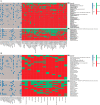Analysis of 61 exclusive enteral nutrition formulas used in the management of active Crohn's disease-new insights into dietary disease triggers
- PMID: 32249975
- PMCID: PMC8653890
- DOI: 10.1111/apt.15695
Analysis of 61 exclusive enteral nutrition formulas used in the management of active Crohn's disease-new insights into dietary disease triggers
Abstract
Background: Exclusive enteral nutrition (EEN) is an effective treatment for Crohn's disease.
Aims: To investigate the hypothesis that ingredients of EEN formulas are unlikely to initiate a disease flare and that their dietary elimination is not essential for disease amelioration.
Methods: We performed compositional analysis of EEN formulas with evidence of efficacy in management of active Crohn's disease. Macronutrient content was compared against the dietary reference values (DRV), the UK National Diet and Nutrition Survey (NDNS) and intake of Crohn's disease children. Food additives were cross-referenced against the FAO/WHO database.
Results: Sixty-one formulas were identified with variable composition (carbohydrates [22.8%-89.3%], protein [7.8%-30.1%], fat [0%-52.5%]). Maltodextrin, milk protein and vegetable/plant oils were the commonest macronutrient sources. Their n-6:n-3 fatty acid ratio varied from 0.25 to 46.5. 56 food additives were identified (median per formula: 11). All formulas were lactose-free, gluten-free, and 82% lacked fibre. The commonest food additives were emulsifiers, stabilisers, antioxidants, acidity regulators and thickeners. Food additives, implicated in Crohn's disease aetiology, were present in formulas (modified starches [100%], carrageenan [22%], carboxymethyl cellulose [13%] and polysorbate 80 [5%]). Remission rates did not differ between EEN formulas with and without those food additives. Analysis including only formulas from randomised controlled trials (RCTs) retained in the latest Cochrane meta-analysis produced similar findings. EEN formulas contained less energy from saturated fat than NDNS intake.
Conclusion: We have identified food ingredients which are present in EEN formulas that are effective in Crohn's disease and challenge perceptions that these ingredients might be harmful.
© 2020 The Authors. Alimentary Pharmacology & Therapeutics published by John Wiley & Sons Ltd.
Figures





Similar articles
-
Exclusive enteral nutrition practices in the management of Crohn's disease: A cross sectional survey of specialist paediatric dietitians.Clin Nutr ESPEN. 2022 Jun;49:252-255. doi: 10.1016/j.clnesp.2022.04.006. Epub 2022 Apr 12. Clin Nutr ESPEN. 2022. PMID: 35623822
-
Partial enteral nutrition induces clinical and endoscopic remission in active pediatric Crohn's disease: results of a prospective cohort study.Eur J Pediatr. 2020 Mar;179(3):431-438. doi: 10.1007/s00431-019-03520-7. Epub 2019 Nov 28. Eur J Pediatr. 2020. PMID: 31781933
-
Crohn's Disease Exclusion Diet Plus Partial Enteral Nutrition Induces Sustained Remission in a Randomized Controlled Trial.Gastroenterology. 2019 Aug;157(2):440-450.e8. doi: 10.1053/j.gastro.2019.04.021. Epub 2019 Jun 4. Gastroenterology. 2019. PMID: 31170412 Clinical Trial.
-
Exclusive enteral nutrition versus corticosteroids for treatment of pediatric Crohn's disease: a meta-analysis.World J Pediatr. 2019 Feb;15(1):26-36. doi: 10.1007/s12519-018-0204-0. Epub 2019 Jan 21. World J Pediatr. 2019. PMID: 30666565 Free PMC article. Review.
-
Use of exclusive enteral nutrition in adults with Crohn's disease: a review.World J Gastroenterol. 2013 Nov 21;19(43):7652-60. doi: 10.3748/wjg.v19.i43.7652. World J Gastroenterol. 2013. PMID: 24282355 Free PMC article. Review.
Cited by
-
The Role of Diet and Gut Microbiota in Regulating Gastrointestinal and Inflammatory Disease.Front Immunol. 2022 Apr 5;13:866059. doi: 10.3389/fimmu.2022.866059. eCollection 2022. Front Immunol. 2022. PMID: 35450067 Free PMC article. Review.
-
How Can a Polymeric Formula Induce Remission in Crohn's Disease Patients?Int J Mol Sci. 2021 Apr 14;22(8):4025. doi: 10.3390/ijms22084025. Int J Mol Sci. 2021. PMID: 33919747 Free PMC article. Review.
-
Nutritional Therapies and Their Influence on the Intestinal Microbiome in Pediatric Inflammatory Bowel Disease.Nutrients. 2021 Dec 21;14(1):4. doi: 10.3390/nu14010004. Nutrients. 2021. PMID: 35010879 Free PMC article. Review.
-
Current Use of EEN in Pre-Operative Optimisation in Crohn's Disease.Nutrients. 2021 Dec 8;13(12):4389. doi: 10.3390/nu13124389. Nutrients. 2021. PMID: 34959941 Free PMC article. Review.
-
The Microbiome in Inflammatory Bowel Disease.J Clin Med. 2024 Aug 7;13(16):4622. doi: 10.3390/jcm13164622. J Clin Med. 2024. PMID: 39200765 Free PMC article. Review.
References
-
- Ng SC, Shi HY, Hamidi N, et al. Worldwide incidence and prevalence of inflammatory bowel disease in the 21st century: a systematic review of population‐based studies. Lancet (London, England). 2018;390:2769‐2778. - PubMed
-
- Hou JK, Abraham B, El‐Serag H. Dietary intake and risk of developing inflammatory bowel disease: a systematic review of the literature. Am J Gastroenterol. 2011;106:563‐573. - PubMed
-
- Wedlake L, Slack N, Andreyev HJ, Whelan K. Fiber in the treatment and maintenance of inflammatory bowel disease: a systematic review of randomized controlled trials. Inflamm Bowel Dis. 2014;20:576‐586. - PubMed
